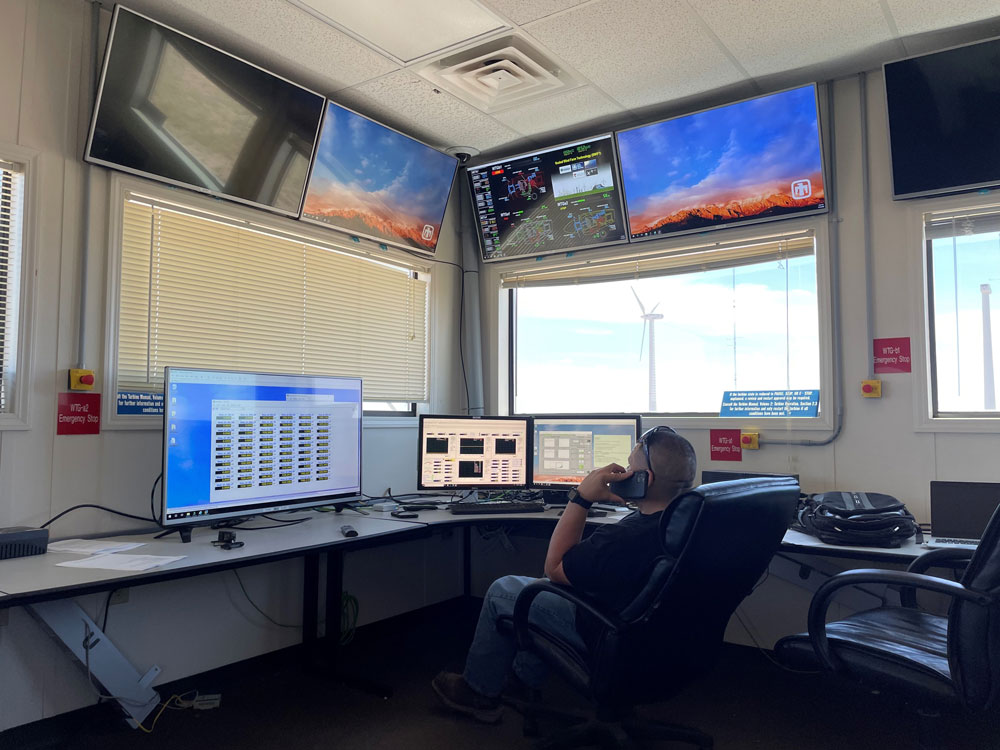Sandia’s Scaled Wind Farm Technology facility reopens for business


The Scaled Wind Farm Technology facility, known as SWiFT, is the first DOE Wind Energy Technologies Office user facility in the U.S. to offer multiple wind turbines to measure turbine performance in a wind farm environment. It serves as Sandia’s premier testing lab for innovative wind turbine rotor designs.
The facility was briefly closed but has reopened with two heavily instrumented meteorological towers and three research-modified Vestas V27 wind turbines. Research performed using smaller wind turbines, like the Vestas V27 turbines, can be directly scaled to much larger turbines, greatly reducing the cost and time needed to setup and conduct experiments. These turbines have been modified and configured to represent the physics relevant to utility-scale machines but are small enough to be cost efficient.
“The SWiFT facility is a center of excellence within the DOE’s portfolio of renewable energy research complexes,” said Timothy Riley, project lead for the SWiFT facility. “This team has much to be proud of, as they have positioned the SWiFT facility to be a sustainable and impactful choice for partnering with others for advancements in wind turbine blade research and turbine controls, as well as meeting the future needs of renewable energy integration.”
Changing the landscape
Sandia proposed the concept of a scaled facility to the DOE in 2011 as a cost-saving solution to wind turbine research. Located at the Reese Technology Center in Lubbock, Texas, SWiFT has evolved into a facility where researchers study the dynamics of turbine-to-turbine interactions and wake dynamics, as well as innovative rotor blade designs. In addition to supporting DOE’s Wind Energy Technologies Office, SWiFT partners with private- and public-sector organizations such as universities, industry and other national laboratories.
Research activities at SWiFT include improving the physical understanding of wake effects; validating high-performance-computing models; reducing wind plant underperformance and operations; reducing operation and maintenance costs from wind turbine interactions and loads; increasing energy capture and reducing imbalance loading and decreasing wake losses with advanced rotor designs. The SWiFT team also leads in blade design and future innovation by advancing knowledge of aerodynamic, aeroelastic and aeroacoustics phenomena and simulation.
“Our dedicated team of researchers, engineers, technologists and environmental health and safety colleagues are driving future innovation by improving our knowledge of wind turbines and providing a safe, public, open-source research testbed to support the broader wind energy community,” Tim said.
Where the wind blows
Over the years, the SWiFT facility’s staff and partners have grown a sustainable and robust safety culture. They have built strong relationships with teams of experts in many fields and have focused on identifying and mitigating potential hazards.
Current partner organizations include Texas Tech University’s National Wind Institute and Group NIRE. Created as a field demonstration site in 2010 by Texas Tech, Group NIRE is dedicated to solving the challenges of integrating renewable energy sources and emerging energy-efficiency technologies with the electric grid.
The groups are working together to integrate the SWiFT facility with Texas Tech’s Global Laboratory for Energy Asset Management and Manufacturing. This move will advance collaborative research in the areas of microgrid and distributed energy, as well as in cyber simulations of microgrid and distributed energy sources.
SWiFT personnel are also working with Texas Tech avian researchers and South Plains College wind turbine technician interns to fully engage Lubbock-area academic institutions. The Sandia wind energy program is exploring how to best use the SWiFT facility’s location at the Reese Technology Center, the more than 19 acres and the assembly and test building subleased from Texas Tech. Activities at the combined property will support the current and future needs of the Wind Energy Technology Office and other DOE research areas, such as possibly using renewable energy for hydrogen generation.
“The team is already looking ahead to potential new areas of research and experimentation at the SWiFT site in Lubbock,” Tim said. “Turbine A1 is operating the National Rotor Testbed project, and Turbine A2 is being readied to support the project’s wake interference testing. The SWiFT project team is also working with investigators to prepare for the Additive Manufactured System Integrated Tip project using the B1 Turbine in the next fiscal year. Additionally, once the interconnect between SWiFT and the Global Laboratory for Energy Asset Management and Manufacturing is functionally tested, there are already projects in development that can very quickly be initiated at the site. These projects will lead to greater use of SWiFT beyond scaled rotor and wake research.”